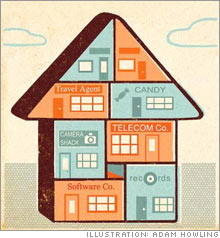|
A hedge fund boosts small stocks
Laurus Funds puts its investors' money on fast-growth microcaps - and minimizes volatility.
(FORTUNE Small Business Magazine) - Hedge funds - invented to hedge bets on stocks and other investments - have lately been associated more with gunslinging managers who expose investors to high levels of risk. Microcap stocks are also notorious for big gains and dips. So how does a hedge fund that specializes in microcaps reduce volatility while still offering double-digit returns? Meet Laurus Funds, a New York City firm with a single portfolio that invests in public companies with market caps below $500 million. The managers at Laurus have started to attract accolades for their unusual risk-management strategy, winning an innovation award recently from industry publication MARHedgeWeek. Since the fund's inception in 2001, it has posted average annual returns of 20.4%, according to Hedgefund.net, while the benchmark HFN Hedge Fund Aggregate index was up 11.25% a year over the same period. Moreover, Laurus Funds' beta score, a measure of volatility, is just 0.09, meaning it is less than a tenth as volatile as the S&P 500 index.
According to co-founder David Grin, 36, the firm has succeeded by identifying fast-growing small public companies and helping finance their growth - funding a new product line, new equipment, or a strategic acquisition. Most microcaps have a hard time finding such backing. They're too small to go to investment banks, and commercial banks favor conservative growth strategies so they attach financial covenants to their loans prohibiting what they consider "risky" actions, such as M&A activity, that may be essential to growth. ("A bank's goal is to get interest," Grin says. "They don't care if the stock price grows five times or ten times or not at all.") Going back to the equity markets for more money is expensive for microcaps because shares get offered at a steep discount to market - Grin says 20% is typical. By contrast, Laurus Funds, with about $1 billion under management, backs small companies in growth mode with a combination of debt and equity. When the analysts at Laurus find a promising microcap - which can be a company with revenues as low as $20 million - they issue convertible bonds, loans that are collateralized by the assets of the company and pay a modest interest rate. If the company's stock price stays level or drops, the bonds must be repaid in cash, typically within 12 to 36 months. But if the company performs well and its stock rises, the bonds convert into equity - generally 10% to 15% above the stock price at the time of the investment. In other words, says Grin, "if the stock appreciates, we make money and management makes money." For investors, of course, hedge funds remain an exclusive club - SEC regulations limit them to qualified investors, and Laurus has a $1 million minimum investment. But if you have the means, the firm's approach offers the growth potential of microcaps while minimizing volatility. -------------------------------------------------- 6 fast-growing stars that may just be The Next Billion-Dollar Big Thing.
Latest status symbol for hedge funds: the $600,000 aquarium. |
|

